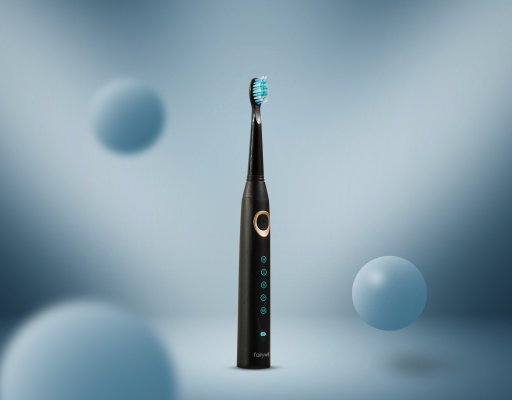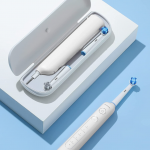Modern-day oral health care experts recommend brushing three times a day to keep cavities from the bay. From ancient sticks and handheld toothbrushes to rechargeable e-toothbrushes, where can technology go? Well, ionic toothbrushes lay right before our eyes, but what’s with this innovation anyway?
To fully understand what this new-gen brush is, we must retrace our steps back to where it starts. We don’t have a master’s degree in history, but we’re fully pledged to delivering straight facts. Without further redo, here’s how the long journey begins.
It’s 3500 BC, and many civilizations have scattered around the globe for both conquest and prosperity. Along the way, our ancestors developed a knack for experimenting with what they can find lying around. Together with the aroma of metalworks in the air they breathe, chew sticks exist.
Historically, Mesopotamia is the first to use these “teeth cleaning instruments.” On one side of the twig, frayed ends resembling bristles for brushing are found. The opposite serves as the toothpick, however.
Sticks are common and prove to be worthy to every craftsman’s working table. But here’s the catch: millions, if not billions of harmful microorganisms are ready to infect your mouth as soon as you use it. As age advances, however, a permanent solution has been created to prevent tooth decay and ensure quality dental care.
Introducing toothbrushes: widely-known for being lightweight and its hair-like bristles where you put in toothpaste and do strokes in your mouth. There are three types that we’ll cover namely manual, electric, and ionic. But please don’t be confused as there are other types as well that will be mentioned in our following reviews.
Manual Toothbrushes
As you have guessed, manual toothbrushes are not battery or electrically powered. It falls on your hands to remove dirt and plaque in your mouth through circular motion. We find this type of toothbrush the most inexpensive choice, with the results depending on how you use it.
Let’s dive one more time back to history in the middle of the Tang Dynasty’s reign in China. This clan has created the first-ever manual toothbrush that closely resembles the modern version. Its base is made from bamboo or bone, atop with hog bristles extracted from extreme regions of China and Siberia.
The Chinese people believed the significant drop in temperature gives them firmer bristles, thus effectively removing plaque. However, it didn’t last as William Addis stole the spotlight after breaking loose from the prison. All that’s left is history after Zhu Wen toppled Emperor Ai to kingdom come and rise with a new order.
Back to the story, who would expect an inmate to be a toothbrush tycoon? With cattle bone, swine fibers, glue, and his skills, a new chapter of his life has started.
Creativity has reached all corners of the world. Since humans are hardwired to renovate for ease, crazy discoveries are found. Even the oral health care sector isn’t spared.
When people got tired of manually brushing their teeth, they started switching from an automated one. Unfortunately, not everyone can afford it. However, these battery-operated devices pack twice or even thrice the punch to kill all germs inside your mouth.
Unlike the conventional type, the electric toothbrush has several attachments to enhance the cleaning experience. Some examples are pressure sensors to avoid over brushing and the well-known QuadPacer for achieving the dentist-recommended brushing time. This type of toothbrush became the meta for people, consequently turning their backs on the old-favorite manual version.
The first electric toothbrush was done by Tomlinson Moseley, patenting Motodent on the 14th of December 1937. If people back then loved grasping thick surfaces, we can’t blame them. The discovery itself is a stepping stone for many more products to come.
Switzerland-based Philippe Woog soon followed the step of Moseley and founded Broxodent in 1954. Six years prior, General Electric introduced a model different from the rest. They are NiCad-powered and bulkier than what we thought – about the size of two D-cell batteries.
Nowadays, electric toothbrush manufacturers like Sonicare and Oral-B use Lithium-Ion and AA batteries. The reason is to decrease weight and make it as slim as what most current models look like. Nonetheless, it brought a significant upgrade when it comes to keeping your mouth bacteria and odor-free.
If manual and electric toothbrushes rely on force and rotations per minute, their ionic counterpart tells a different story. Most models are lightweight and don’t require add-ons. However, it has its unique parts that we’ll explain later.
Models of this toothbrush type can be handheld or battery-operated, and both are scientifically proven to be effective. But to what extent? Well, since an electric toothbrush is better than a manual, the same applies to ionic versions.
In physics, an ion can be an atom, molecule, or particle with a net electrical charge. Charges come with positive (cation) or negative (anion) and play an essential role in cleaning the teeth.
Google Patents record shows Kazutoshi Kaizuka, a Japanese national, invented the tool. He described it as a toothbrush with a far-infrared emitting material and minerals with many elements. As we have mentioned earlier, it exists to prevent periodontal conditions.
On behalf of its creator, Create Co Ltd filed a patent on the 6th of November 2001. Four years later, the application was granted and is currently waiting for expiration in September 2022.
Learning how an ionic toothbrush works allows you to take advantage of its beyond extraordinary capability. Not only are you saving the cash for your toothpaste, but also your precious time and effort. But hey, we recommend you buy a mouthwash if you’re suffering from garlic breaths (no offense).
Once you inspect the toothbrush model, you’ll see a small titanium battery at its handle. This component is the product of combining a standard alkaline battery and small amounts of titanium. As a result, the resistance is lowered, making it more efficient when used in portable electronics.
However, we’re concerned about the consequences it might create since lowering the resistance increases the current flow. And once the flow of current is high, it risks lethal shock currents that may zap unfortunate users. Luckily, the chances of getting electrocuted significantly drop thanks to a protective casing and your skills in using the toothbrush.
Running all over the body is a titanium rod connected to the small battery. On top of it is a thin metal plate or band that you’ll grip into while brushing. Make sure to moist those hands so the effect can take place.
Once it’s in your mouth, this is when the real show happens. Remember the charges we have mentioned earlier? It will move inside your mouth, repelling every dirt and plaque it encounters.
Dissimilar charges attract each other, and similar charges repel each other. Since our teeth surface has anions while plaque possesses cations, an ionic toothbrush produces similar positive charges, repelling the two. This process effectively cleans the teeth.
Three distinct types of toothbrushes put to the test - and there are lots of studies out there to link. But first, what’s so special about an ionic toothbrush that some people are going nuts for it? Here is everything we know:
- Ionic Bonding
Particles are adjusted to remove plaque. Making it happen is as simple as wetting your hands, gripping the metal plate, and brushing your teeth.
- No more bleeding
If you love your teeth healthy and hate every bit of dirt and plaque inside it, an ionic toothbrush can save you. It takes little to no effort at all since you’ll be relying on ionic bonding. It’s the most brilliant move you can take without blood coming out from your gums or teeth.
- Saves Cash
Let’s be realistic here: if you bought this toothbrush versus the other types, it’d be cost-effective in the long run. Toothpaste and brush heads will all be marked out from your next Amazon shopping list. But seriously, we recommend using one to have a fresh breath.
- Lighter is Always Better
With the growing demand for oral hygiene instruments, user comfort is always considered. That’s why many toothbrushes are lightweight and portable, so people can brush whenever, wherever they like.
- A Perfect Investment
Once you find the perfect model, don’t let it go. Remember, it’s inexpensive (not all) and delivers a whole new level of brushing.
Experience has taught us how helpful the toothbrush is as we test. However, those are the only things we’ve noticed while using it. People have their beliefs, and it’s not enough if there’s no concrete evidence with these claims.
In Tokyo, 30 volunteers with no health issues were randomly given manual and ionic toothbrushes. The researchers conducting the study instructed them to brush for two minutes and apply plaque staining solution to their teeth. After two phases, the result has been conclusive that ionic toothbrushes are better than manual ones.
A pretty similar study was performed as well to emphasize the brushing capabilities of this type of toothbrush. But in this case, the research team assesses the strengths and weaknesses of active (with Li-Ion) and inactive ionic (without Li-Ion) toothbrushes.
After undergoing dental prophylaxis – a meticulous process of cleaning the teeth – all 20 subjects were given the equipment. Data is gathered weekly, which lasts for 49 days. Again, this research is one of many justifications that an ionic toothbrush is leading-edge.
According to the results, there’s a significant difference in plaque index and gingival bleeding index when the toothbrushes come into action. But it’s evident that both indexes are significantly reduced. However, an active ionic toothbrush proves to be superior in terms of removing plaque. No soft tissue trauma was also recorded, which reveals it’s safe to use.
It’s crucial to know how the plaque and gingival bleeding index means and how it can help to assess someone’s oral health. Basically, a plaque index spots visible plaque on the lingual and vestibular teeth surfaces except for molars. On the other hand, a gingival bleeding index is designed for recording inflammation through interproximal gingival sulci. This area is where gums and teeth meet.
It took ionic toothbrushes a while to join the world of oral health care. From hands to motors and motors to ionic bonding, who could’ve thought this game-changing brush would exist? Imagine the spent years with ups and downs to make one of the finest inclusions in your hygiene arsenal.
This present-day cleaning tool is indeed a product of curious minds looking for ease and reducing injuries while toothbrushing. By pressing gently and letting your wet hands touch the metal plate, ionic charges adjust the polarity of the mouth. In return, buildups are repelled, neutralized, and removed.
Several papers containing scientific testimonies show its remarkable efficiency in removing plaque and reducing the chance of bleeding gums. Not only you’re getting an upgraded brushing, but also ensuring your safety. It’s a nice perk.
There are also statistical research studies supporting its superiority among manual and electric toothbrushes. Honestly, it’s a matter of preference on what type to choose. But sometimes, it’s best to switch to something beneficial with guaranteed safety.
However, not all about ionic toothbrushes is a world full of gains. You’ll still be dealing with a slight misfortune that you might commit. There are no issues at all if you’re the type who’s into this tool. Unfortunately, you still have to keep an eye on the small titanium battery posing a risk once mishandled.
One terrible mistake and an electric shock will follow. This is because the titanium battery has low resistance, making the current flow higher. As a result, the performance is induced, otherwise the very reason why it’s exceptionally invaluable.
Generally, using this toothbrush the right way can turn the tables if your teeth are beyond saving – literally! It has soft bristles for transferring charges and ultimately cleaning your mouth. It’s only a matter of minimal effort and teeth exposure to change how you see an ionic toothbrush.





